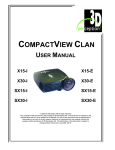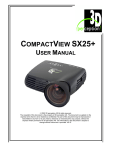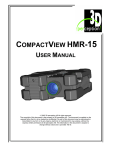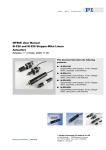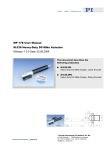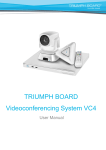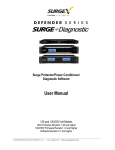Download CompactView X10 - About Projectors
Transcript
CompactView X10 USER MANUAL VERSION 2 3D Perception CompactView X10 Projector and accessories CompactView X10 Communication cable EVC Cable Figure 1.CompactView X10 and accessories 2 TABLE OF CONTENTS 1 BEFORE YOU START ......................................................................................................................................................................4 1.1 Accessories.................................................................................................................................................................................4 1.2 Insert batteries in the remote control ..........................................................................................................................................4 2 IMPORTANT NOTICE ......................................................................................................................................................................5 3 CONNECTING A SOURCE SIGNAL TO THE COMPACTVIEW X10 PROJECTOR ......................................................................................6 3.1 Connecting an image generator to the CompactView X10 Projector .........................................................................................6 3.2 Connecting a Computer Graphics Source to the CompactView X10 Projector ..........................................................................6 4 COMPACTCONTROL AND COMPACTDESIGNER SOFTWARE PACKAGE ..............................................................................................8 4.1 About CompactControl................................................................................................................................................................8 4.2 About CompactDesigner.............................................................................................................................................................8 4.3 Installation...................................................................................................................................................................................8 4.4 Software License ........................................................................................................................................................................9 5 GETTING STARTED WITH COMPACTVIEW X10...............................................................................................................................10 5.1 Connecting a single projector ...................................................................................................................................................10 5.2 Connecting Projectors in a Chain .............................................................................................................................................11 6 USING THE COMPACTVIEW X10 PROJECTOR ...............................................................................................................................12 6.1 Different program modes for the COMPACTVIEW X10 projector.................................................................................................12 6.2 COMPACTVIEW X10 Remote Control .........................................................................................................................................13 6.3 Using the touch panel on the COMPACTVIEW X10 projector......................................................................................................15 6.4 Adjusting the height and angle of the COMPACTVIEW 10 projector ...........................................................................................16 6.5 Adjusting Focus/Zoom on the COMPACTVIEW X10 projector.....................................................................................................16 7 USING THE MENUS ......................................................................................................................................................................17 7.1 Main menu ................................................................................................................................................................................17 7.2 Set-up menu .............................................................................................................................................................................18 7.3 Control panel menu...................................................................................................................................................................21 7.4 Product information...................................................................................................................................................................24 8 MAINTENANCE ............................................................................................................................................................................25 9 WHAT TO DO IF (TROUBLE SHOOTING) .........................................................................................................................................26 9.1 Further assistance ....................................................................................................................................................................27 10 TECHNICAL SPECIFICATIONS .......................................................................................................................................................28 11 LIMITED WARRANTY, ‘FCC STATEMENT’ AND ‘TRADEMARKS COPYRIGHT’.....................................................................................30 3 1 BEFORE YOU START THANK YOU FOR CHOOSING THE 3D PERCEPTION COMPACTVIEW X10 PROJECTOR The COMPACTVIEW X10 projector will display high brightness images with vivid colours, even under normal light conditions. As input for your presentation you can use CD-I, CD-ROM, Photo CDs, Laser Disks, DVD, normal VCRs or computers. You can have multiple inputs connected simultaneously for high impact multimedia presentation. 1.1 Accessories Please take a few minutes to make sure that your COMPACTVIEW X10 projector contains all the necessary parts: see figure 1. 1.1.1 • • • Cables for control through CompactDesigner software Communication cable – 2m/6ft Spiral cable with RJ12 connectors EVC cable 3 x Power cable – (Europe, U.S.A. and U.K.) 1.1.2 Other accessories Please refer to our website at www.3d-perception.com 1.2 Insert batteries in the remote control Figure 2 shows the remote control with the battery lid removed. Slide off the battery lid and insert the batteries with the + and - poles correct. Slide the battery lid back on again. Figure 2: Inserting batteries in the remote control 4 2 IMPORTANT NOTICE The warranty card or copy of invoice is your proof of purchase. Please make sure that the warranty card is returned in order to get the warranty service you are entitled to. Failure to return the warranty card may void your warranty. NOTE! PLEASE USE CAUTION WHEN TRANSPORTING THE UNIT. WARNING! TAMPERING WITH OR OPENING THE COMPACTVIEW X10 CAN BE DANGEROUS. FOR REPLACEMENT OF THE LAMP SEE THE INSTRUCTIONS SUPPORT WITH THE REPLACEMENT LAMP. LEAVE MAINTENANCE TO AUTHORISED 3D PERCEPTION SERVICE PERSONNEL. PLEASE CONTACT YOUR VALUE ADDED RESELLER WITH ANY SERVICE OR MAINTENANCE QUESTIONS YOU MAY HAVE. 5 3 CONNECTING A SOURCE SIGNAL TO THE COMPACTVIEW X10 PROJECTOR 3.1 Connecting an image generator to the CompactView X10 Projector The procedure for connecting an image generator to the COMPACTVIEW X10 projector is the same for all types. 1. Make sure that the image generator; the monitor and the COMPACTVIEW X10 projector are switched off. 2. Identify the RGB out connector on the back of your image generator (where you would normally connect a monitor). 3. Connect the image generator to the COMPACTVIEW X10 projector using the communication cable. 4. Turn on the COMPACTVIEW X10 projector and then the image generator. The image should now be projected from the COMPACTVIEW X10 projector. 3.2 Connecting a Computer Graphics Source to the CompactView X10 Projector The procedure for connecting a computer graphics source to the COMPACTVIEW X10 projector is as follows: 1. Make sure that the computer graphics source and the COMPACTVIEW X10 projector are switched off. 2. Connect the VGA cable from the computer graphics source to the enhanced video connector on the COMPACTVIEW X10. 3. When connection has been achieved and verified, switch on the computer graphics source and the COMPACTVIEW X10 projector. 4. The COMPACTVIEW X10 projector will now automatically display the pictures from the computer graphics source. If not, see the section ‘What do I do if’. 6 Control chain out Control chain in Enhanced video connector Figure 3: Connection Panel 7 4 COMPACTCONTROL AND COMPACTDESIGNER SOFTWARE PACKAGE The CompactControl and CompactDesigner software may be installed either directly from a CDROM or by downloading from the Internet. After registering with 3D Perception, and depending on the type of software license purchased, you will have either CompactControl or CompactDesigner loaded on your PC. CompactControl provides the user with full geometry correction, edge control, gamma control and colour control of projectors whereas CompactDesigner, as well as offering all that CompactControl offers, also facilitates the complete design of projection theatres along with indepth analysis. 4.1 About CompactControl CompactControl allows the user to set up a model of the actual theatre scenario and to place the projectors in the theatre model at the correct physical locations. CompactControl then allows the user to perform geometry adjustment, edge blending, gamma correction and colour balancing in order to create a continuous picture with evenly distributed light intensity. Projection theatre geometry is downloaded to the projectors for easy calibration of geometry, soft edges and hot spot compensation. 4.2 About CompactDesigner CompactDesigner, whilst offering all the same facilities as CompactControl, also assists in the designing of Projection Theatres based on known room measurements, specifics of projectors and screen geometry. Many of the processes are automated. The designer may input various types of screens or screen elements, projector types, position both screen and projectors, define eye point, or even multiple eye points for simulation activities that require this. CompactDesigner calculates the parameters for very accurate Non-Linear Image Mapping (NLIM) in order to provide a high quality image as seen from the selected eye points. Between projectors, the designer is free to select edge blending zone and the intensity fall off characteristics, hot spot compensation level, and gamma correction and colour balance. All to create a seamless continuous picture with evenly distributed light intensity. 4.3 Installation The CompactControl and CompactDesigner software is delivered on CD-ROM media, or may be downloaded from the Internet. You may either have a CD with software, or a downloaded self-extracting executable file. 8 1. Installation from CD-ROM Insert the CD. automatically. Depending on your computer’s set-up, the installation program may start If it does not, you need to locate the set-up program on the root directory of the CD: Double-click the icon to start the set-up procedure. 2. Installation from self-extracting executable Locate the executable file and double-click its icon to start the set-up procedure. The installation procedure will now guide you through the set-up process. NOTE: There is an on-line ‘Help’ that is delivered with the CompactDesigner software, including a ‘Quick Guide’, which gives detailed step-by-step instructions on the setting-up and use of the system. 4.4 Software License The set-up program requires you to enter a valid software license serial number. The first time you run the set-up program, the serial number will be set to a dummy value: CV0000-0-0000-00000000-00000000. Use this default value to calculate the machine ID. The serial number is based on a unique ID of the target computer. To obtain a full license, you will need to run the set-up program once to calculate the ID, which must be sent to your distributor for a license serial number to be generated. When you have received the serial number for your machine, run the set-up program again. The serial number must be entered exactly to allow set-up to continue. The set-up program will not allow you to continue until a valid license serial number has been entered. Depending on the type of software license purchased, you will now have either CompactControl or CompactDesigner loaded on your PC. 9 5 GETTING STARTED WITH COMPACTVIEW X10 5.1 Connecting a single projector 1. Connect the projector to a video signal source using the supplied cables. The video signal must be connected to the ‘Enhanced Video Connector’ Port on the projector. Control chain out Control chain in 2. Connect the Control PC (running CompactDesigner or CompactControl) to the projectors ‘Control chain in’ input. The supplied 6-lead cable (Figure 4) plugs into the PC’s serial port using an adapter (Figure 5). Enhanced video connector Figure 3. Connection panel 3. Connect the projector to AC power and switch on. 4. Start CompactDesigner or CompactControl (depending on your software configuration). If the software has not yet been installed on the target machine, it will have to be installed first. See chapter 4.3. Figure 4. Communication cable Figure 5: Serial port adapter For detailed instructions on using the software, please refer to the on-line Help, section ‘Quick Guide’. 10 5.2 Connecting Projectors in a Chain Multiple projectors may be connected together in a ‘daisy chain’ by using the input and output connectors on each projector. The first projector is connected to the host PC using a 6-lead cable with RJ-12 connectors on both ends. This cable connects to the PC through the supplied adapter (9-pin to RJ-12). The other end plugs into the ‘Control Chain in’ port on the first projector. From the first projector, another 6-lead cable connects between the ‘Control Chain out’ port on the first projector to the ‘Control Chain in’ port on the second projector. This chain can be extended up to the theoretical limit of 255 projectors in a single chain. In Out In Figure 6: Connecting projectors in a ‘Daisy chain’. 11 Out In 6 USING THE COMPACTVIEW X10 PROJECTOR 6.1 Different program modes for the COMPACTVIEW X10 projector The COMPACTVIEW X10 projector has different modes of operation: 1. 2. 3. 4. 5. 6.1.1 Stand-by mode Normal mode Quick mode Menu mode Blank mode Stand-by mode In stand-by mode the projector is turned off and can be turned on by using defined keys, see section 6.3 6.1.2 Normal mode In normal mode a picture will be shown on the screen. 6.1.3 Quick mode Quick mode is used with the interactive remote control (quick key). You assign functionality for the quick key on the remote control in the quick menu (see section 7.2.5). When clicking on the Quick key you will be able to switch between all the functions you have selected in this menu. 6.1.4 Menu mode In menu mode the menu system is activated and you use the mouse pad and the mouse buttons on the remote control to navigate in the menu. 6.1.5 Blank mode In blank mode the screen is blanked out (black). 6. Using the 3D Perception projector 12 6.2 COMPACTVIEW X10 Remote Control The COMPACTVIEW X10 remote control provides access to the Main Menu, which in turn facilitates control of the various image adjustments and utility functions of the COMPACTVIEW X10 projector Pointing it towards the projection screen operates the remote control. An infrared beam bounces from the screen to an infrared receiver on the COMPACTVIEW X10 projector. NOTE! Make sure nothing is blocking the IR receiver in front of projector located beside the lens, as this will prevent the communication between the remote control and the COMPACTVIEW X10 projector. To ensure smooth operation, the combined distance from the remote control to the screen and back to the projector should not exceed 10 meters (33 ft). If the distance via the screen is longer, you should point the remote control directly towards the IR receiver. The remote control works with Macintosh and with Microsoft Windows, for interactive distance control of your computer. A unique pressure-sensing pad on the remote makes it very easy to control. The Remote control is very easy to operate. It has only six keys in addition to the pressure sensing mouse pad. 13 Key underneath the control Enter. Small grey key Interrupt/break an action (right mouse key) Menu The menu key gives access to the COMPACTVIEW X10 menu control functions. To move within the various menu functions, position the arrow cursor by pressing the sensitive mouse pad and click with the left mouse button which is located underneath the remote control. If you are in menu mode and press the menu key you will return to normal mode Zap The two zap keys can be programmed to perform an assigned function. To assign a function to the zap keys, select the Zap icon from the menu. The zap keys can be programmed to do the same function. See section 7.2.5 for further explanations of the zap menu. Figure 7: The remote mouse Quick When pressing the Quick key you can switch between all selected functions for the Quick key. See section 7.2.4 for how to select functions for the Quick key. Figure 8: The remote mouse communicates with the COMPACTVIEW X10 projector via the projection screen 14 6.3 Using the touch panel on the COMPACTVIEW X10 projector The touch panel gives you direct access to the most important functions of the COMPACTVIEW X10 projector. It is very handy to use when the remote control has low batteries, or you simply have forgotten to bring it with you. Remember, these controls are also available from the software. The key functions are as follows: Source The COMPACTVIEW X10 projector has direct keys for input selection, PC being the norm. Brightness The Brightness key is used to control the brightness in data and video image. Contrast The Contrast key is used to control the contrast in data and video image. Figure 9: The keys on the touch panel on the COMPACTVIEW X10 Stand by The stand by key will set the COMPACTVIEW X10 projector in stand by mode. The lamp will turn off, and the fans will run for a little while cooling the projector before stopping. To return to normal mode, press the Stand by key once more, or press the Menu key on the remote control. Automatic set-up The automatic set-up key will set up the projector with optimal settings for the connected source. If you want to do manual adjustments you can do this by using the menus (see section 7). NOTE! Some features of the screen menu system can only be accessed via the remote control. 15 6.4 Adjusting the height and angle of the COMPACTVIEW 10 projector You can adjust the height and angle of the COMPACTVIEW X10 projector by adjusting the four small feet underneath the product. NOTE! The COMPACTVIEW X10 projector should never be left with an angle of more than 15 degrees over a longer period of time. This will shorten the lifetime of the lamp. FOCUS 6.5 Adjusting Focus/Zoom on the COMPACTVIEW X10 projector To adjust focus, turn the outer part of the lens (1). To adjust zoom, turn the inner part of the lens (2). 16 7 USING THE MENUS The following menus are accessed through the IR remote control: 1. 2. 3. 7.1 Main menu Set-up menu Control panel menu Main menu The main menu is divided into two parts: • Icons • Help text Icons The icons illustrate a function and are grouped into groups with similar functionality. Clicking an icon activates it. Some icons have a direct function and some will activate a second level menu. Help text By moving the cursor over the icons the text area will give a short description of the icon. Stand by This function sets the projector in stand-by mode Auto set-up Auto set-up will do automatic set-up of the projector: • Horizontal and vertical position • Sampling clock • Phase • Chooses between available video formats and NTSC/PAL auto detection (Video option only). Source (Video option only) You can connect three different sources to the COMPACTVIEW X10 projector, one computer source and two video sources. You select the source you want to use by clicking on the icon representing the source. Use the pressure-sensing pad on the remote mouse to move the mouse pointer to an icon and click the button (left mouse) underneath the remote mouse. In this menu you can make adjustments for picture and sound. 17 Set-up menu In this menu you set up the projector with settings that will not be changed often, e.g. language, mouse system or picture orientation. Control panel In this menu you can make adjustments for picture and sound. Removing the main menu To remove the menu system, press the MENU key on the Interactive Remote control. The menu will disappear when active for 40 seconds. 7.2 Set-up menu In the set-up menu the following sub-menus are available: • • • • • • 7.2.1 Picture orientation Language Mouse system Quick key assignment ZAP keys assignment Lamp hours Picture orientation NOTE: Although picture orientation is possible from the set-up menu it is strongly recommended that this function be performed from within the CompactDesigner software. The picture orientation menu is used for rotating and mirroring the picture. Normal Normal is used when the projector is standing on a table projecting a picture on a screen. Mirror Mirror is used when the projector is projecting the picture from the back of the screen Rotate Rotate is used when the projector is ceiling mounted and projecting image from the front. Rotate and mirror Rotate and mirror is used when the projector is ceiling mounted and projects the picture from the back of the screen. 18 7.2.2 Language This menu allows you to choose between six different menu languages: English Norwegian German Italian French Spanish Click in the box next to the language you want to use. Click on the OK button. The window will disappear, and the selected language will be used in the main menu and in all other menus. 7.2.3 Mouse system Not applicable. 7.2.4 Quick menu settings In the quick menu you can assign functionality for the quick key on the remote control. When clicking on the quick key you will be able to switch between all the functions you have selected in this menu. In this example, the first time you click on the quick key you will activate the volume function. A volume bar will be displayed at the bottom of the projected image where you can adjust the volume up and down. You adjust the bar by either pressing the pressure-sensing pad right or left or you may use one of the two zap keys on the remote control. To accept the adjustment, and terminate the quick menus click on the left mouse button. To get back to the original volume, click on the right mouse button. The next click on the quick key will accept the volume adjustment and activate the brightness function and a brightness bar will be shown at the bottom of the page. When you have gone through all assigned functions the menu will disappear. 19 7.2.5 Zap menu The Zap menu is used to assign functions to the zap keys on the remote control. The menu consists of two columns of buttons where the left column assigns the functions to the Zap 1 key and the right column assigns the functions to the Zap 2 key. Volume Not applicable Pointer Not applicable Blank Activates blank mode by pressing the Zap key. First click will activate Blank mode and second click will deactivate it. Mute Not applicable Computer Selects Computer as source. Video (Optional) Selects video sources. Both Zap keys can be programmed to select Video (video input 1 or 2). Tuner Not applicable. TV channel Not applicable. 20 7.2.6 Show accumulated lamp time In this window you can see the accumulated time that the lamp have been used. You also use this window to reset the accumulated lamp time when you have changed lamp. 7.3 Control panel menu In the control panel you have access to menus for adjusting picture and audio settings. The icons ”Picture positioning” and ”Synchronisation Adjustments” are only visible if PC source is active. 7.3.1 Picture control Select the picture control menu for adjusting brightness, saturation and tint. 21 When PC is selected as source and auto contrast is marked, only brightness will be available. When PC is selected as source, only brightness and contrast will be available. (Optional) When PAL/SECAM video is selected brightness, contrast and saturation will be available. (Optional) All options will be available for NTSC video. Select OK to save your changes and exit, or select Cancel to exit without saving your changes. Selecting Default restores factory settings. 22 7.3.2 Picture positioning Adjust vertical and horizontal position of the picture on the screen with the two sliders. Select OK to save your changes and exit, or select Cancel to exit without saving your changes. 7.3.3 Audio control Not applicable. . 23 7.3.4 Synchronisation adjustments It is possible to adjust the synchronisation in Computer mode by adjusting the Phase and the Frequency. The synchronisation will be set by the automatic set-up function. Manual sync adjustments should typically not be required. 7.3.5 Colour manager The colour manager is designed to give you maximum performance from your projector, independent of ambient light conditions. In the colour manager menu you can choose between four pre-defined Colour settings. 7.4 Product information Click on the product information icon in order to get information about the product and company. Select Exit to leave the menu 24 8 MAINTENANCE All maintenance should be done by 3D Perception authorised service personnel. Contact your 3D Perception Value Added Reseller for maintenance. The 3D Perception projector lamp is designed to give you 2000 hours performance. In the unlikely event that you should have to change the lamp, you will find complete instruction on how to replace the lamp included in the spare lamp kit. 25 9 WHAT TO DO IF (TROUBLE SHOOTING) NOTE: The following are some of the typical problems encountered by users of the CompactView X10. If you have detected a problem not listed here, or if after trying the suggested remedies the problem still exists, you should contact your Value Added Reseller immediately. No image appears on the screen Possible causes and remedies: 1. The CompactView X10 projector is left in Standby mode. If the product is in standby mode, there will be a red light next to the stand-by button. Press the stand-by but-ton or the Menu key on the remote control. 2. The lamp does not function. Check the light on the control panel. If the light is orange, first check if the projector has been re-set too quickly after turn-off by pressing the red standby button. If the light is still orange the lamp does not function. Contact your Value Added Reseller. 3. The product is set in ‘blank mode’. Press the zap keys on the remote control. 4. The brightness is turned on too low. Adjust brightness until a satisfactory image is achieved. 5. The power saver or screen saver on the PC or other image generator is turned on. Turn off the power saver and screen saver on the image generator. 6. The image is displayed on the laptop screen and not the projector. Activate the external port on the laptop by pressing the required key combination on your computer. 7. The CompactView X10 projector is not connected to electricity. Check that the power cable is connected to the CompactView X10 projector and the wall outlet. No source signal is detected (‘3D Perception’ appears on the screen) Possible causes and remedies: 1. The computer has not been switched on. Turn on the computer. 2. The cables are not properly connected. Check all cable connections. 3. There is no electricity in the power outlet in the wall. Check that there is power in the power outlet. NOTE! When all connections to electricity are OK, there will be a green light at the control panel. The image is not good (noise) Possible causes and remedies: 1. The automatic image set-up is not activated. Run auto set-up by pressing the green button on the touch panel or run auto set-up from the menu. 2. The synchronisation on the PC is not set optimally. 26 There is poor response from the Interactive Remote Control Possible causes and remedies: 1. Check that nothing is blocking the IR receiver at the front of the 3D Perception projector. 2. Make sure the remote is pointed towards the screen. 3. Make sure there is no more than 10m/33ft in distance to the projector. 4. Batteries might be low. Change batteries in the remote control. 5. Electromagnetic or optic noise may influence the remote control. Turn off sharp fluorescent tubes, mobile phones etc that are near the projector. No Image Appears Possible causes and remedies: 1. The 3D Perception projector has not been switched on. Check the ON/OFF switch at the back. 2. For Notebooks: The external RGB port may need to be manually activated. Please consult the notebook-operating manual for how to operate. 9.1 Further assistance Further assistance can be found in the comprehensive on-line ‘Help’ feature in the section entitled ‘Troubleshooting’. You are also invited to visit our web site www.3d-perception.com 27 10 TECHNICAL SPECIFICATIONS Resolution: 1024 x 768 Colour resolution: 24 bits (30 bits internal processing) Response time: 16 ms Processing Latency: 50 us – 12 ms (geometry dependent) Projection Lamp: Lamp life: Brightness: Contrast Ratio: 150W UHP 2000 Hours typical 1000 ANSI Lumens 500: 1 (ANSI Full on/off typical) Projection Lens: Carl Zeiss Zoom Lens Vertical Frequency: 48Hz – 100Hz Horizontal Frequency: 15KHz – 80KHZ Dimensions: 13.2 ins (W) x 8.86 ins (D) x 5.72 ins (H) 335 mm (W) x 225 mm (D) x 145 mm (H) Weight: 10.2 lbs (4.6 kg) Geometry Processing 100 Megapixels/second (full signal rate) Non-linear mapping: Fully digital image re-sampling Soft edge blending: Fully digital in all directions Colour balance: Fully digital Gamma correction: Fully digital 28 Image Width v Throw Distance Chart The following diagram illustrates the relationship between image width and throw distance for a flat screen. 29 11 LIMITED WARRANTY, ‘FCC STATEMENT’ AND ‘TRADEMARKS COPYRIGHT’ Limited Warranty Except as otherwise stated herein, 3D Perception warrants to the first end-user (‘Customer’) who purchases a 3D Perception projector from a Value Added Reseller that the 3D Perception projector is free from defects in parts and labour under normal use during the warranty period. The warranty period means the 12-month period from the date of the Customer’s purchase of the 3D Perception projector from a Value Added Reseller. During the warranty period, 3D Perception will, at its option and in its sole discretion, repair or replace defective parts, including replacement of the entire 3D Perception projector, at no additional charge to the Customer. However, the Customer is responsible for all shipping and insurance costs incurred in returning any 3D Perception projector to the Customer which does not require any repair or replacement work, as determined by 3D Perception in its sole discretion. This limited warranty does not extend to the 3D Perception projector lamp and does not extend to any 3D Perception product that has been dam-aged as a result of accident, misuse, or abuse. Nor does it extend to the use of parts not manufactured or sold by 3D Perception, by unauthorised modification of the 3D Perception projector, or as a result of servicing by unauthorised personnel. This limited warranty extends only to the Customer, and is not transferable or applicable to any other third party or user, including any one who purchases a used 3D Perception projector. Any person asserting a claim under this limited warranty must establish to 3D Perception satisfaction the date of purchase and that the 3D Perception projector was purchased new. Other warranty and liability limitations Aside from this standard published warranty, 3D Perception makes no warranty of any kind, express or implied, including without limitation, those of merchantability and of fitness for a particular purpose. Without limiting the generality of the foregoing, any description of the 3D Perception projector is for the sole purpose of identifying it, is not part of the basis of any bargain, and does not constitute a warranty that the item sold shall conform to that description. The use of any sample or model is for illustrative purposes only, it is not part of the basis of any bargain, and it is not to be construed as a warranty that the 3D Perception projector will conform to the sample or model. No affirmation of fact or promise made by 3D Perception shall constitute a warranty that the 3D Perception projector will conform to the affirmation or promise. 3D Perception makes no warranty that the goods are free from claims of infringement of patents, trademarks, or copyrights. This limited warranty shall be the exclusive remedy. 3D Perception shall not be liable to customers or others for incidental, consequential, or special damages, or lost profits. Under no circumstance shall 3D Perception liability or customer’s remedy for damages against 3D Perception exceed its cost for the 3D Perception projector. 30 Procedure for claims Any and all questions or claims concerning the 3D Perception projector shall be made to 3D Perception authorised personnel. In no case shall the 3D Perception projector be returned without first securing the authority of 3D Perception or its authorised personnel. Any damages to, defects in, loss of, non conformities in, or any other claim concerning the 3D Perception projector which could be discovered by inspection upon delivery must be reported to the delivering carrier, and in writing to 3D Perception at: the following address, promptly and in no event later than thirty (30) days after delivery. 3D Perception AS Solbråveien 41 P.O. Box 455 N-1373 Asker Norway In the case of any such claim, inspection shall be promptly arranged with 3D Perception or it’s authorised personnel, and where appropriate, representatives of the carrier. Any other claim or action respecting the condition or conformity of the 3D Perception projector or any other matter affecting the 3D Perception projector must be submitted in writing to 3D Perception promptly upon discovery and in no event later than expiration of the Warranty Period. Any part of the 3D Perception projector which is subject of any claim shall be set aside and protected, without further processing or use, until 3D Perception or its authorised personnel have an opportunity to inspect it and advice the Customer of the disposition, if any to be made thereof. Failure to give timely written notice of any claim shall bar any remedy. Technical advice 3D Perception, or its authorised personnel, may furnish technical advice with reference to the use of the 3D Perception projector, but there is no obligation to furnish such advice. If any advice or assistance is furnished, it shall be given and accepted at Customer’s risk, 3D Perception shall not be responsible or liable for the advice or assistance given or the results thereof. FCC Statement The 3D Perception projector has been tested and found to comply with the limits for a 'Class A' digital device, pursuant to Part 15 of the FCC rules. These limits are designed to provide reasonable protection against harmful interference when it is operated in a commercial environment. The 3D Perception projector generate, uses and can radiate radio frequency energy and, if not used in accordance with the instructions manual, may cause harmful interference to radio communications. Operation of the 3D Perception projector in a residential area is likely to cause harmful interference in which case the user will be required to correct the interference at own expense. Trademarks Copyright 3D Perception is a registered trademark. IBM is a registered trademark of International Business Machines Corporation. Apple Macintosh and Apple Powerbook are registered trademarks of Apple Computer Inc. Other trademarks are the property of their respective owners. Norwegian and foreign patents are pending. 31 Contact information 3D PERCEPTION AS Solbråveien 41 P. O. Box 455 N1373 Asker, Norway Tel: Fax: e-mail (sales): e-mail (tech support): www.3d-perception.com 32 +47 66 98 70 70 +47 66 98 70 71 [email protected] [email protected]
































